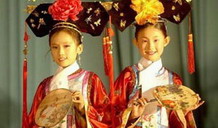Turpan
"Wear fur in the morning, but gauze at noon; hug the stove while enjoying melons" is a popular saying in Xinjiang. The first half of the saying depicts the huge temperature disparities in a single day, while the latter half is a description of a common but interesting phenomenon in Turpan. Hami melons and watermelons in Turpan can be preserved until the following spring. Watermelons are therefore also available in the winter: A fire is kindled in a stall for warmth as the seller sells his watermelons.
Besides its tremendous heat, Turpan is also the driest place in China, with an exceptionally low annual precipitation rate. Tuokexun County in the southwest part of Turpan has an annual rainfall of only 3.9 millimeters, and Shanshan County in the east, just 25 millimeters. Located in the center, Turpan city gets just 16 millimeters of rain. Compounding that, the region's evaporation reaches 3,000 millimeters per year. Snowfall in Turpan is even less common, averaging less than 2 millimeters per year.
The heavy but infrequent showers in Turpan come mostly in the summertime. Locals joke that if you stand properly between the big raindrops in Turpan, your clothes will not get wet.
However, all yearlong, snow on the Bogeda Mountain provides enough water for living and agricultural purposes.
Due to the serious lack of rain and snow, the Turpan Basin has, since ancient times, relied on an underground water irrigation system. The Karez -- the region's famed irrigation system -- creates a unique scene in Turpan. The system skillfully draws water from underground via a string of underground channels.
Thanks to the region's unique and favorable natural conditions, such as sparse rainfall and a dry climate, historical relics and ruins, both above and below ground, have been preserved for a very long time.







